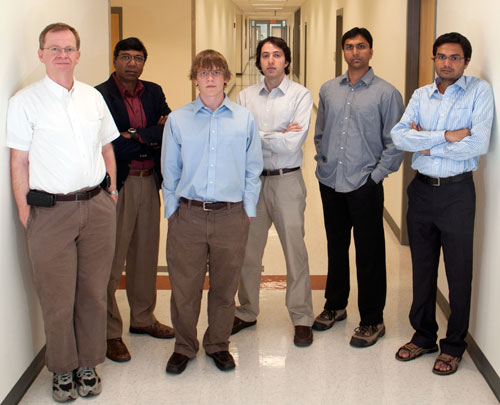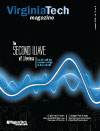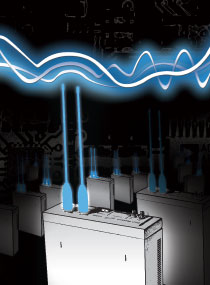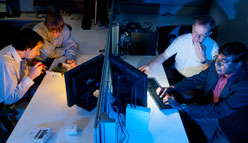 |
|
||||||
|
|
|||||||||||||||||||||||||||||||||||||||||||||||||||||||||||||||||||||||||||||||||||||||||||||||||||||||||||||||||||||||||||||||||||||||||||||||
|
The Second Wave of Wireless
by LYNN NYSTROM and JESSE TUEL
In evolutionary terms, radios today are developing brains. The cognitive experimentation is under way via Wireless@VT, the nation's largest communications-network research center. The progress is most evident in the cognitive radio test bed, the first network of its kind at any university in the country, which is housed in the Institute for Critical Technology and Applied Science's (ICTAS) newest building at the corner of Stanger and Old Turner streets. Haris Volos, a postdoctoral associate with Wireless@VT, demonstrated the cognitive system at its most basic level, showing a video of a student purposely interrupting communication between two radio nodes in the 48-node system by changing channels on a store-bought hand-held radio. In response, the cognitive system automatically switches frequencies, from channel 7 to channel 8, back to 7, then to 14. "For us, this [demonstration] is rudimentary, very basic," Volos said, "but it captures the essence." The system recognizes, adapts, and remembers. This intelligence is the next frontier in radios and networks. With smarts comes socialization. "We approached this network like you would approach a community of animals," said Charles W. Bostian, Alumni Distinguished Professor Emeritus of Electrical and Computer Engineering. "First, we teach the radios to seek others of their own kind and recognize their environment, thus creating a network. Then our team teaches the different cognitive radios to work together." Like living creatures, the radios are aware of their surroundings and understand capabilities and limitations. Intelligence in a cell phone or police radio allows the device to determine the best way to operate in any given situation. Instead of following a set of predefined protocols, as regular radios do, cognitive radios configure to their environment and their users' needs. "Every cognitive radio has a knowledge base it has learned over time. Now, our research makes it possible for all cognitive radios to be connected in a network where that information can be shared in what we characterize as a cognitive network," said Bostian. For a number of reasons, cognition will be critical for the second wave of wireless technology. The second wave The first wave of wireless development, stretching from the late 1980s into the late 2000s, was characterized by the proliferation of data. Today, wireless technology is gathering its strength for a giant leap forward, and Virginia Tech is the launching pad. The implications are hard to overstate. Globally, the second wave of wireless will be a "disruptive technology," said Jeff Reed, director of Wireless@VT and an icon in the field of wireless technology. Wireless access in even the most remote third-world areas will allow these regions to skip the hefty infrastructure costs of wired access and accelerate the social and economic trajectories of the world's poorest countries. Cognitive radios will send more consistently secure signals, aiding greatly in military intelligence. Smart phones will enable commerce, while smart grids will support energy efficiency. The unrest and collapse of countries such as Egypt in the early part of 2011 serves as an example of this acceleration. "Who knows how many Einsteins might be living in the deserts of Egypt who could really excel" as they grab hold of the second wave of wireless, said Reed, the Willis G. Worcester Professor in the Bradley Department of Electrical and Computer Engineering.
Reed noted that the iPhone alone increased AT&T's data load 80 times over. "Mobile data traffic will increase some 450 times between 2005 and 2015. The spectral efficiency doubles every 18 months," he said. In other words, there is backbreaking congestion on the Internet superhighway. As a result, researchers are tasked with alleviating the bandwidth problem. The spectrum needed to carry the additional traffic currently exists, Reed said, but due to current government-regulated allocations, this space is off-limits to wireless providers, especially in the United States and other developed countries. At Rutgers University, the Wireless Information Network Laboratory (WINLAB) and its director, Dipankar Raychaudhuri, are collaborating with Tech researchers on a major federal research initiative to study technologies for efficient, or "dynamic," spectrum access. Raychaudhuri described spectrum as a finite resource, the only component of the wireless equation that cannot be enhanced by buying more equipment and developing new technology. Spectrum allocated for a specific purpose—for example, military and emergency communications—could be shared with secondary users when dormant. Cognitive radios will sense the environment and allocate spectrum appropriately. (The video shown by Volos, in which the cognitive system switches frequencies, is a simple example.) In its earliest stages, dynamic spectrum access is "something that Virginia Tech has been quite active in," Raychaudhuri said, adding that it is "a common goal for WINLAB and Virginia Tech, and something we look forward to cooperating with them on." Along with spectrum efficiency, new avenues for the next generation of wireless are being considered. Television whitespace is an example of untapped bands of the wireless transmission spectrum. These bands, especially between the 50-700 megahertz frequencies that now go unused, could be available for broadband wireless communication. Also, the introduction of femtocells, small cellular base stations designed for use by a homeowner or a small business, can connect users to a service provider via broadband. Reed has proposed a new model for service providers in developing countries. Low-cost 4G femtocells and cellular modems can be located in small rural communities and powered by renewable energy resources. The femtocells are then connected back to the wired network using low-cost unlicensed whitespace devices. In the research stages now, the model could be ready for deployment in several years, Reed said. Residents of developing countries will then have access "to telemedicine, remote education, and micro-finance, all of which hinge on a communications infrastructure," Reed said, while providing "developing nations with a way out of investing in and building expansive and costly communications infrastructure." Reed predicted the second wave of wireless technologies will reshape the way humans perceive and interact with each other and the world around them. If pioneering companies adjust their business models, the new wave could make expansion of broadband and wireless technologies into developing nations far more efficient and profitable. "In the repair business, think of the common occurrence of a jam in a copy machine," Reed said. "Rather than call a service person to the site, the operator can point a cell phone camera at the machine, send the picture to the supplier, and a fix would be transmitted back, all via wireless technology. The intelligence might be in the network, the phone, or the copy machine." A powerhouse of wireless research In the Wireless@VT lab in ICTAS, the cognitive radio system enables Reed and others to implement and test their algorithms, protocols, applications, and hardware technologies that support whitespace communications. Most importantly, these tests now occur in a live environment, rather than computer simulations or one-to-one radio interactions. Researchers are hard at work improving the cognitive radio's smart engine, which drives the radio's ability to "monitor its own performance continuously, read the radio's outputs to determine the radio frequency, channel conditions, and adjust the radio's settings to deliver the needed quality of service," Reed said. By incorporating cognition into radio and network operations, "we can make efficient use of the spectrum, achieve rapid deployment, lower maintenance, and provide network security," Reed said. Given the scope of tomorrow's wireless networks—in effect, a blanket of wireless access coating the Earth—automated thinking and learning will have to control the connections. Ahead of this scenario, Tech researchers are figuring out how. In the first phase of wireless development, the devices did not generally have access to unutilized processing power and information on equally similar nodes. "The advent of self-organizing distributed ad-hoc networks has improved the interaction and collaboration among nodes," Reed said. "More recently, radio devices for communication have been applied to collect and process sensor information, such as environmental data, which can then be shared with other nodes." According to Roop Mahajan, ICTAS director and the James S. Tucker Professor of Engineering, "The potential for development and refinement of research-based findings through the institute's test-bed installation is an outstanding example of the kind of impact that this institute was created to inspire and support." Tamal Bose, associate director of Wireless@VT and a professor of electrical and computer engineering, agreed. "Many of our proposals have capitalized on the test bed as a valuable infrastructure for research. In fact, several proposals have been successfully funded as a result of it. This unique and important infrastructure has positioned us very well as a leading research institution in wireless communications." Case in point: The premier electrical engineering journal, The Proceedings of the IEEE (the Institute of Electrical and Electronics Engineers), invited Tech researchers to publish a 2009 paper, "Cognitive Radio and Networking Research at Virginia Tech." In it, the authors cited a handful of other noteworthy university research efforts, such as Georgia Tech and the aforementioned WINLAB at Rutgers. Rutgers' Raychaudhuri said Virginia Tech's wireless efforts are evidence of the time and investment necessary to influence the field. "There was a particular mass of expertise," he said of Tech's early years. "That has continued, and new faculty members have become involved over the years. We have good relationships with all the universities specializing in wireless. It's a friendly community. Virginia Tech is in the front rank of wireless research centers nationally." Another top-tier academic research operation is Georgia Tech's Wireless Systems Laboratory in the School of Electrical and Computer Engineering. Director Gordon Stüber spoke highly of Virginia Tech's most notable wireless names, such as Theodore Rappaport, now at the University of Texas at Austin, for his work in propagation (defining how radio waves move and how they are distorted), and Reed and others for expertise in software-defined radio and cognitive radio. Virginia Tech "certainly has a good reputation," Stüber said. "They do good work." This powerhouse of wireless research at Virginia Tech is attracting nearly $10 million per year in research funding. Since 2005, the wireless group has received funding from the U.S. Air Force, National Institute of Justice, National Science Foundation, Office of Naval Research (ONR), U.S. Army Research Laboratory, Defense Advanced Research Project Agency (DARPA), Electronics and Telecommunications Research Institute, and other organizations. Santanu Das, an ONR program officer, has worked directly with Virginia Tech researchers. "ONR recognizes the significant contributions and benefits stemming from university partnerships and research initiatives," Das said in a statement. "With naval tactical communications mostly wireless in nature, ONR seeks and draws upon world-class research from groups such as [the researchers at] Virginia Tech, who are noted for leading-edge contributions in areas of radio and networking technologies." In the midst of these game-changing technologies, the international concern about network security remains. Tech researchers are working on this quandary with funding from DARPA and ONR. Reed, Bose, Madhav Marathe of Virginia Tech's Virginia Bioinformatics Institute, and a team of graduate students are developing a new technique for security called wireless distributed computing. The researchers said that the advanced concept will perform computationally intensive applications, such as geolocation, coordinated jamming, distributed sensing, and real-time image processing. With a wireless channel between nodes, the distributed computing problem becomes very complex. Depending on the condition of the wireless channel, researchers are determining whether the complex computations to process data can be executed locally on a single radio node or in a distributed manner on a collaborative radio network such as the one in the on-campus ICTAS facility. This collaborative approach can benefit and assist radios with limited computational power, such as handheld radios, cell phones, or unmanned aerial vehicles. Devices based in aerial vehicles, for instance, could form a network that captures images of ground activity and compresses the images before transmitting them to a warship. Foundational research Overcoming challenges is a mainstay of the university's wireless group. Over the past four decades, the work of Tech engineers in this burgeoning field has served as the technological basis for companies such as Direct TV, Iridium Satellite, and Globalstar, Reed said. Beginning with their first NASA-funded project in 1971 and continuing through the 1990s, Bostian and Warren Stutzman, both professors emeriti in the electrical and computer engineering department, led Tech's satellite communications efforts, building ground stations for global satellite communications and characterizing the propagation environment. Rappaport's work proved key to understanding cellular instrumentation, emergency 911 geolocation, and more. "The work they started impacted standards and real systems used by industry and government," Reed said. A defining moment for the Virginia Tech wireless group came in 1993 when Reed was one of the researchers to land the group's first major funding from DARPA, a $1.7 million contract to develop a revolutionary approach to wireless communications. The Hokies combined new technologies in computer chips, antennas, and digital signal processing in a novel way, eventually allowing wireless devices to be extremely small, yet able to adapt to interference in a radio channel. They accomplished their goals and showed an order of magnitude increase in the number of radio devices that could share a single radio frequency, thereby increasing the capacity of wireless users in a specific region of space. This award started the long-standing relationship between Virginia Tech and DARPA that remains in place today. Quickly taking the form of viable business models, Tech-based research paved the way for consumer products. Companies emerged, including the first wireless communications company in Blacksburg, TSR Technologies, which later was sold to Grayson Electronics. In 1998, a second spin-off, Wireless Valley Communications Inc., was founded and later sold to Motorola for $30 million. Within a few years, some of the technologies that Virginia Tech had developed included SIRCOM, an indoor channel modeling program; CELLSCOPE, a technology that identifies a person using a cellular phone; SMT, a site-modeling tool for indoor communications that led to the Wireless Valley Communications formation; Stallion, a high-performance computing device for handsets; and Interactive Video, a wireless mechanism for users to order products they see advertised on TV. In the past couple of years, new companies, such as Cognitive Radio Technologies and Power Finger Printing, have spun out of the research group. Some of the other wireless projects the various Tech groups were working on are commonplace today, such as Bluetooth technologies that enable indoor location; software radio for wireless communication interoperability; smart antenna technologies to eliminate co-channel interference; and advanced wireless modems to support remote computing and high-speed wireless access to the Internet. Researchers were instrumental in the improvement of cellular communications to prevent co-channel interference and reduce power consumption, and they developed the experiments and testing methodologies that today allow 911 callers to be located. Tech researchers were working on Global Positioning Systems, originally hatched as applications for emergency vehicles, more than a decade before the systems became popular Christmas presents for directionally challenged drivers. From the cognitive radio test-bed control room, Volos showed a second video, demonstrating the radio nodes' ability to locate a moving radio. Embedded in the ceiling, the nodes tracked a small Motorola radio held by a student walking down the hallway. As the student ambled farther away, the node nearest the radio detected the strongest signal strength. The nodes lit up sequentially, whispering to each other about the individual's presence. Volos described how radio waves perceive the walls of ICTAS as semitransparent, even when the exterior walls are clad in Hokie Stone. Emanating in an omnidirectional fashion—circularly, like a donut—from the radio nodes within, the waves cooperate internally and push their findings outward, just like Tech's wireless experts. Constantly conceiving, creating, and deploying new technologies, researchers at Virginia Tech are shaping the wireless wave that will dramatically alter social, cultural, economic, and military landscapes the world over.
|
|
||||||||||||||||||||||||||||||||||||||||||||||||||||||||||||||||||||||||||||||||||||||||||||||||||||||||||||||||||||||||||||||||||||||||||||||
|
|




